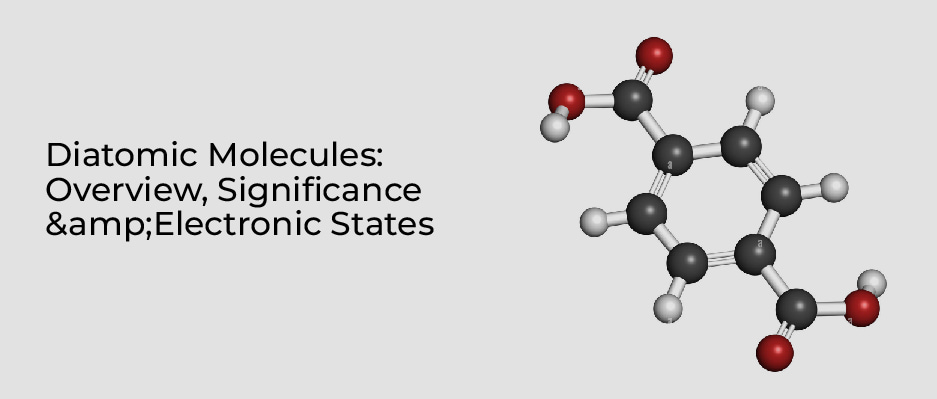
Diatomic Molecules: Overview, Significance & Electronic States
Table of Contents
Diatomic molecules or diatomic elements are the one which contain two chemically bonded atoms. If the two atoms are similar, such as in the oxygen molecule (O2), they form a homonuclear diatomic molecule, while if they are different, as in carbon monoxide, they assemble into a heteronuclear diatomic molecule (CO), where they make up the heteronuclear diatomic molecule.
Heat capacity
In diatomic molecules like oxygen and polyatomic molecules like water, there are additional rotational motions, which store thermal energy in their rotational kinetic energy. The diatomic molecules can rotate about two axes, so each additional degree of freedom adds more R to cV.
Heteronuclear Molecules
All other diatomic molecules are chemical compounds of two various elements. Pressure and temperature combine to produce heteronucleardiatomic molecules.
The gases nitric oxide (NO), hydrogen chloride (HCl), and carbon monoxide (CO) are examples.
Several 1:1 binary compounds are not usually considered diatomic due to the fact they are polymeric at room temperature, but when evaporated, they produce diatomic molecules; for example, gaseous SiO, MgO, etc.
Occurrence
Scientists have identified hundreds of diatomic molecules in interstellar space and in the laboratory. About 99% of Earth’s atmosphere is composed of two species of diatomic molecules: oxygen (21%) and nitrogen (78%). The natural abundance of hydrogen in the atmosphere of Earth is only a few parts per million. Nevertheless, hydrogen is the most universally abundant diatomic molecule. In the interstellar medium, hydrogen atoms dominate.
Molecular Geometry
All diatomic molecules are linear and are characterized by a single parameter, which is the distance between the two atoms. While the diatomic nitrogen atom has a triple bond, the diatomic oxygen atom has a double bond, while the diatomic hydrogen, fluorine, chlorine, iodine, and bromine atoms all have single bonds.
Historical Significance
In the 19th century, carbon played a key role in elucidating the principles of atom, molecule, and the fact that elements like oxygen, nitrogen, and hydrogen exist as diatomic molecules. The original atomic hypothesis of John Dalton assumed that all the elements were monoatomic and that the atoms present in compounds would commonly have the simplest atomic ratios with respect to each other. Consider, for instance, that Dalton assumed water to be HO, giving oxygen an atomic weight eight times that of hydrogen, instead of the modern value of up to 16. Therefore, there was uncertainty about molecular formulas and atomic weights for almost half a century.
In 1805, von Humboldt and Gay-Lussac demonstrated that water consists of one volume of oxygen and two volumes of hydrogen, and also in 1811, Amedeo Avogadro derived the exact composition based on what is known as Avogadro’s law and the diatomic molecule assumption.
However, until the 1860s, these observations were dismissed, partly due to the assumption that atoms of one element would not have chemical affinity with those of a similar element, and partly due to the obvious exceptions to Avogadro’s rule that were not clarified until later, such as the dissociation of molecules.
At the Karlsruhe Congress on atomic weights in the 1860s, Cannizzaro revivified Avogadro’s theories and used them to construct a coherent table of atomic weights that largely agrees with current principles. By Lothar Meyer and Dmitri Mendeleev, these weights were said to be prerequisites to the discovery of periodic law.
Excited Electronic States
Usually, diatomic molecules are in their ground state, also known as the ‘X’ state. As the diatomic molecules’ gas is bombarded by energetic electrons, a few molecules will be excited to higher electronic states. For suppose, in the natural aurora, nuclear explosions at high-altitude and rocket-borne electron gun experiments. Excitation can also occur when a gas absorbs light or other electromagnetic radiation.
Furthermore, the excited states are unstable and naturally return to the ground state. After excitation (typically over fractions of seconds or longer in the case of a metastable excited state), transitions take place from the higher to lower electronic states and eventually to the ground state, and for every transition, a photon is emitted. Fluorescence is the name given to this emission.